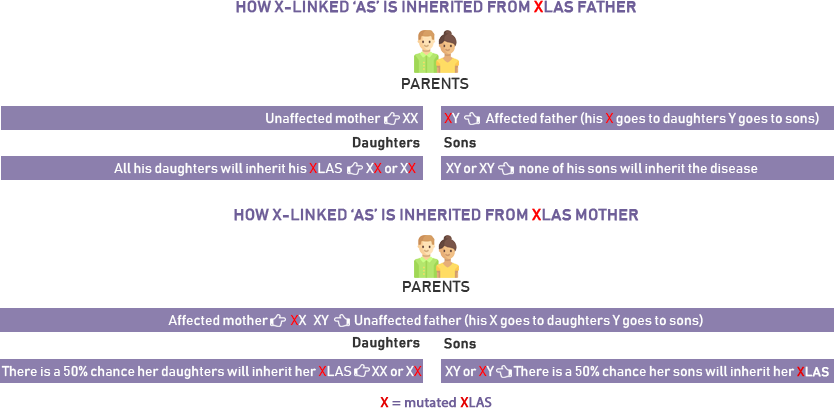Alport Syndrome Background
![]()
[/vc_column_text]
Alport Syndrome is a hereditary kidney disease, sometimes referred to as hereditary nephritis.
Symptoms of Alport Syndrome include blood in the urine (which may not be visible), protein in the urine (trace to large amounts), a significant deterioration in renal function, high blood pressure, hearing loss, and possible vision problems. The degree of symptoms varies between families and also between sexes, as female sufferers may have very mild symptoms, and therefore go undiagnosed until passed on to their children. The outcome for males is often more severe, with 90% of males suffering renal failure by the age of forty. Renal failure requires patients to undergo frequent kidney dialysis and eventually a renal transplant.
If anyone in your family is diagnosed with Alport Syndrome it is vital that all members of the family, male and female, investigate the possibility that they too have inherited the disease. Genetic counselling is recommended, and genetic testing whenever possible.
Why are the kidneys, ears and eyes affected in Alport Syndrome?
Firstly we need to understand that the body is held together by connective tissue and this connective tissue is made up of “collagen”, which itself consists of strands of proteins assembled like the strands in a rope. There are many “types “of collagen throughout the body, and type IV collagen is found only in basement membranes of the glomerulus (the filter) of the kidney, the cochlea of the ear and the lens of the eye.
Specific genes carry the information (or pattern) for the “knitting together” of the strands of protein to form collagen. Hence any mutation in a “type IV” pattern carrying gene will have the potential to affect the ear, the eye and the kidney. The most serious problems arise from impairment of the glomerulus of the kidney.

How do you inherit Alport Syndrome?
There are three different types of inheritance. These will often determine the age onset of symptoms and their severity, although it is now known that patient experiences vary and that several factors, such as lifestyle and other inherited traits, may influence how and when symptoms will occur.
(1) X Linked Alport Syndrome (XLAS)
80% of individuals with Alport Syndrome.
X Linked Alport Syndrome is the result of an inherited mutated gene on an X chromosome, referred to as XLAS (X Linked Alport Syndrome).
The X chromosome is called the female sex chromosome, and the Y chromosome is called the male sex chromosome. We all have two sex chromosomes. Females have two X chromosomes (XX), and males have one X and one Y chromosome (XY). We inherit only one of these chromosomes from each parent, thus determining whether are are born female (XX) or male (XY).
Males (XY) inherit either one of their mother's X chromosomes, and from their father they inherit his Y chromosome.
Females (XX) inherit either one of their mother's X chromosomes, and from their father they inherit his X chromosome.
Either parent can have the mutated gene carried on their female sex chromosome, XLAS. This explains why the disease is usually more severe in men (XY) than in women (XX), as generally if females inherit one 'mutated' XLAS chromosome from their AS affect parent they will also inherit one 'good' X chromosome from their other parent which provides a varying degree of protection from severe symptoms and slows down the progression of the disease.
Males can only inherit X Linked Alport Syndrome from an affected mother carrying the XLAS. There is a 50% chance a male will inherit the XLAS chromosome from his affected mother, and a 50% chance he will instead inherit her unaffected X chromosome, and therefore not have Alport Syndrome. Males cannot inherit the XLAS from their father because males only inherit the Y chromosome (the male sex chromosome) from their father. Thus, an affected father cannot pass X Linked Alport Syndrome on to his sons.
However, a female can inherit the mutated gene from her affected 'carrier' mother or from her affected father. There is a 50% chance a female will inherit the XLAS chromosome from her affected ‘carrier’ mother, and a 50% chance she will instead inherit her mother’s unaffected X chromosome, and therefore not be affected by Alport Syndrome. But it is certain a female will inherit the XLAS chromosome from an affected father. Fathers must pass on the XLAS (their only female sex chromosome) to all female children. Keep in mind that women have two X chromosomes and so will inherit an unaffected X chromosome from the unaffected parent. This is why is it very important that when a family member is diagnosed with Alport Syndrome all the related women should consider genetic testing whether they show symptoms or not.
X Linked Alport Syndrome usually progresses more rapidly in males than females, and often symptoms are diagnosed at an earlier age. Renal failure, or 'end stage renal disease' (ESRD) usually occurs in males between the ages of 30 and 50, and often the renal function of females never require them to undergo dialysis nor renal transplant.
See below on this page “Transfer Rules for XLAS to the Next Generation” for further explanation and a diagrammatic representation.
(2) Autosomal Recessive Alport Syndrome (ARAS)
About 15% of individuals with AS.
A recessive mutated gene on an autosome (not a sex linked chromosome) will be overridden by a working gene. Thus, for the offspring to develop AS, they must receive a recessive mutated gene from both parents. If an individual has only one mutated recessive gene, then he/she is a carrier of AS, but will not usually develop the disease. Both males and females are affected equally with Autosomal Recessive Alport Syndrome and may develop any or all symptoms of the disease, and possibly end stage renal disease (ESRD) by the age of 30.
(3) Autosomal Dominant Alport Syndrome (ADAS)
Quite rare, about 5% of individuals with Alport Syndrome.
A mutated gene exists on one of the numbered chromosomes. There are two copies of every chromosome, and the dominant mutated gene will override the working gene. However, this form of the disease progresses more slowly than other forms.
Transfer Rules for XLAS (X Linked) to the Next Generation:
Fathers pass a copy of their Y (male) chromosome to their sons. Thus sons of male XLAS sufferers have 0% chance of inheriting XLAS. Fathers pass a copy of their X (female) chromosome to their daughters. Thus, ALL daughters of a male with X linked Alport Syndrome (XLAS) will have a 100% chance of inheriting the disease.
All sons and daughters of a woman carrying Alport syndrome (XLAS) have a 50% chance of receiving their mother’s mutated XLAS chromosome, as the mother will always pass on one of her two X chromosomes (X, or the mutated XLAS).

Why is it important to locate Alport sufferers?
An Alport carrier may be unaware of any problem, even at age 30. By then the mutation may have been passed on to the next generation. However, if we know that certain family members have XLAS then it is possible to determine who in the family tree is at risk. Finding other living family members who may unknowingly have Alport Syndrome will benefit those people in two ways: firstly by early detection (a simple urine and blood test is a good start) and seeking treatment much sooner, giving them better health outcomes and secondly, they may choose to discuss family planning with their doctors or a geneticist to avoid the genetic condition in their future generations through Preimplantation Genetic Diagnosis or Testing (PGD or PGT) as part of an IVF process. In Australia couples with a high risk of having a child affected by a genetic disorder may now access PGT and receive a Medicare rebate.
Treatment of Alport Syndrome
At present there is no cure for Alport Syndrome. Certain blood pressure lowering medications (ACE inhibitors) are known to also decrease the amount of protein leakage from the kidneys and delay the onset of end stage renal disease (ESRD). Other medications are available and may also be prescribed by clinicians for patients they deem would benefit from the treatment. The current aim of treatment is to slow the progress of the disease, and if possible prevent ESRD.
Hearing aids and lens replacement of the eye may be required in the treatment of some Alport sufferers. A healthy diet consisting of low salt and low protein is usually recommended in order to ease the pressures on the kidney. When or if kidney failure occurs, dialysis is recommended, and transplantation may be an option for the patient.
There is well deserved optimism that current research will lead to reversal/cure. It is early days for this, but when something comes through it is most important to find people who can benefit from current developments.
Current recommendations for the treatment of Alport Syndrome include:
๏ the use of genetic testing as the gold standard for the diagnosis of Alport syndrome and the demonstration of its mode of inheritance;
๏ the need to identify and follow all affected members of a family with X-linked Alport syndrome, including most mothers of affected males;
๏ the treatment of males with X-linked Alport syndrome and individuals with autosomal recessive disease with renin-angiotensin system blockade, possibly even before the onset of proteinuria;
๏ discouraging the affected mothers of males with X-linked Alport syndrome from renal donation because of their own risk of kidney failure;
๏ consideration of genetic testing to exclude X-linked Alport syndrome in some individuals with thin basement membrane nephropathy.
Extract from "Expert Guidelines for the Management and Treatment of Alport Syndrome & Thin Basement Membrane Nephropathy". Judy Savige(1), Martin Gregory(2), Oliver Gross(3), Clifford Kashtan(4), Jie Ding(5), and Frances Flinter(6)
A guide for patients with Alport Syndrome
This document contains information for patients and families diagnosed with Alport Syndrome. It has been reviewed by the Medical Advisory Committee of the Alport Foundation of Australia.
→View and print the Patient Guide
